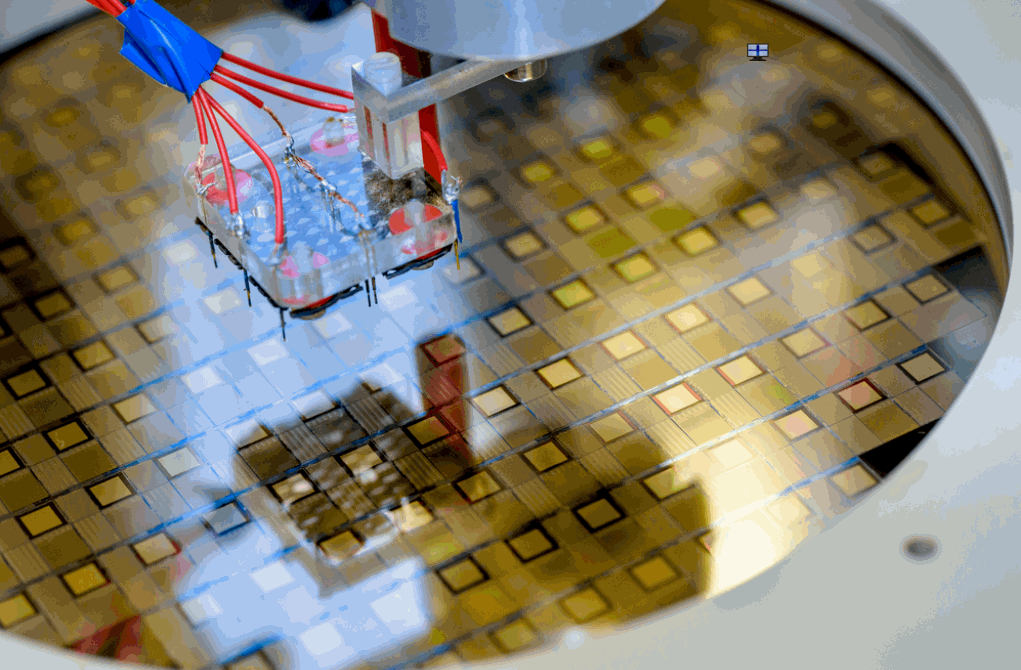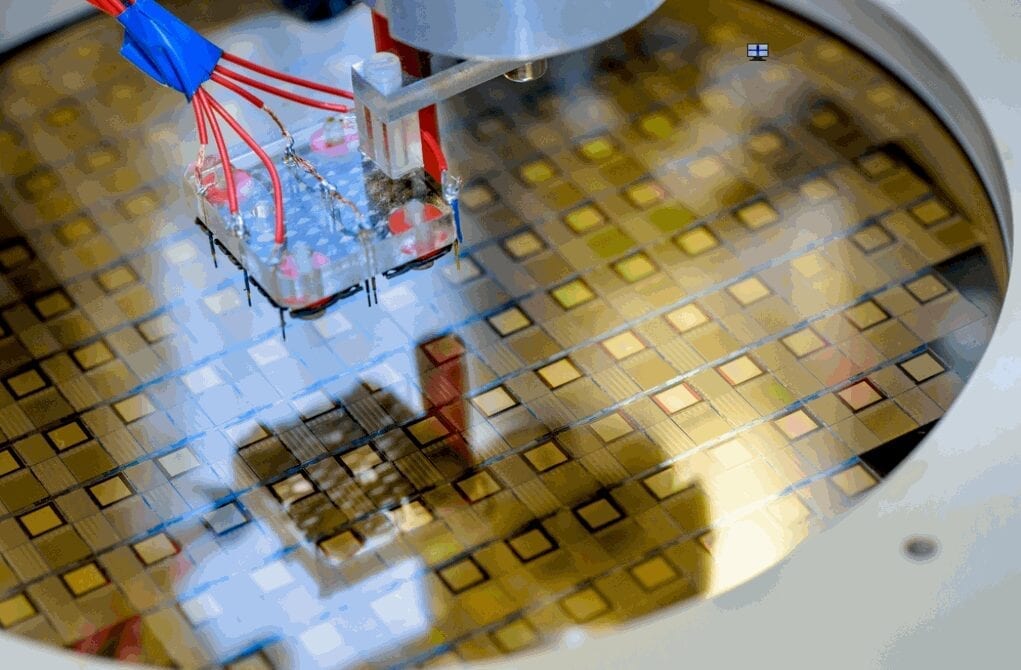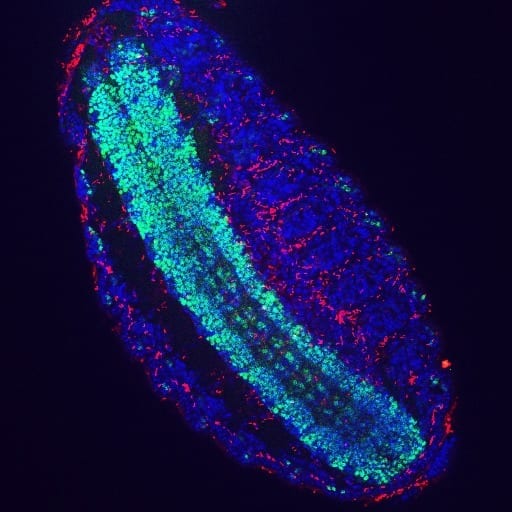
Autonomous micro labs the size of cells that monitor chemical systems from the inside – pure fiction, as yet. But several crucial steps have been taken.
Lablets, as Prof Dr John McCaskill refers to them, are microscopic electronic particles that he and his partners have developed in the recent years. Currently not larger than 140 x 140 x 60 micrometres, they are capable of exchanging information, controlling various chemical reactions in aqueous solutions, and absorbing information from their environment. One day, they should be able to pair up autonomously and acquire the capability to evolve. In order to construct these micro-agents, researchers have learned quite a few things by observing nature.
The abilities of the micro labs may bring to mind scenarios from science fiction films, where artificial units undergo autarkic development to form larger organisms and, eventually, run out of control. “We are still far from anything like that being possible,” reassures John McCaskill, Head of the group Microsystems Chemistry and Biomolecular Information Processing. “We should be in awe of the things that nature is capable of. Even if our project ends up being one hundred per cent successful, our micro labs won’t be able to perform even a fraction of the things that living cells achieve with regard to evolution.”
McCaskill has long been researching methods of electronically controlling chemical processes. “If we want to control them from the outside, we need comparatively huge, complicated interface structures,” explains the biophysical chemist. Consequently, he explored the possibility of controlling the processes from the inside. “Our aim was to cut the umbilical cord to lab control,” says McCaskill. That would pave the way for numerous new applications.
The micro labs are capable of perceiving chemical signals as well as directing reactions, specifically in settings that large instruments cannot access or where they would be in the way – for example in the human body. As McCaskill elaborates: “Just imagine what a chemist could achieve if he was as small as a cell.”
In order to realise the micro-agents, researchers had to design the required electronic components in a very small format, have them manufactured, and had to figure out the complete production process of the microsystems based thereon. Many of the applied methods were derived from processes that are deployed in the manufacture of traditional microchips.
On one wafer, the researchers implemented half a million micro labs at the same time. Step by step, they assembled the electronic layers on the wafer and fitted them out with a superstructure that will be housing, for example, the power supply unit. Protected and mediated by special coatings, the electronics also work in aqueous solution. In the last step, the researchers have the individual units cut out of the wafer. Following three years of research in the EU project “Microscopic Chemically Reactive Electronic Agents”, short Micreagents, the micro labs boast quite a few capabilities.
Power supply on board
The researchers have developed a supercapacitator for the micro labs, also known as lablets. At present, it stores so much energy that the micro-agents can operate autonomously for 20 minutes. All processes are optimised for using as little power as possible.
Currently, the lablets have to return to a dock to recharge; the dock is a smart surface that is connected to a computer in the outside world. The micro labs can also be programmed via the dock. One day, the surface should become obsolete. Researchers have already developed ideas for how the lablets could draw energy directly from the surrounding solution.
Manipulating the environment
Microscopic electrodes in the lablets can trigger chemical reactions – which ones, depends, among other factors, on the molecules that are available in the environment. The energy necessary to initiate a reaction can be supplied by the voltage at the electrode. Different voltages cause different reactions. Ultimately, the material deposited on the surface of the electrode also determines which chemical processes are triggered.
In the course of those processes, substances can deposit at the electrode and alter the surface; as a result, the micro lab becomes capable of starting reactions that differ from the ones before. The history of which voltage was applied when, determines which molecules are deposited at the electrode and, consequently, which reactions may follow next.
The researchers are able to programme a sequence of voltage signals into the lablets, whose function is similar to that of the genome of living cells: the DNA specifies which chemical processes control the proteins in a living cell. The voltage sequence determines which chemical processes the lablets trigger in their environment. In the micro labs, the electric signals thus fulfil the function of a DNA sequence which is translated to chemical products. A limited repertoire of chemical reactions has already been tested by the Micreagents team; for example, the lablets are capable of changing the pH-value of the surrounding solution, triggering reactions that generate light or releasing metal ions or other small molecules that turn on specific DNA cleavage or ligation reactions (video).
Perceiving and moving
Not only can the micro labs influence their environment, they are also able to perceive it, for instance by measuring the concentration of a substance in their environment. Thus, they are in principle capable of moving along a concentration gradient in a similar way that bacteria do, and, for example, to swim to the spot with the highest volume of a specific substance.
Even though McCaskill’s group has not yet tested autonomously movable micro labs in an experiment; some of the lablets have been designed for this task and the process simulated. For this purpose, electro-osmosis is used as an actuator: electrodes can accelerate charged particles close to their surface. Friction is generated between those particles and the particles of the liquid above, thus accelerating the liquid. The momentum spreads to the layers above; a flow is created. Conducting that flow through the nozzles of a lablet, larger recoil could be generated. The lablets would not exactly break any speed records, but they would travel the length of their own diameters within seconds.
Docking to the surface
The chemists can program the micro labs via the dock and supply them with electricity. To this end, the lablets have to find the way to the surface, remain there for a few moments, and then disengage again. For this to work, the project partners are equipping the lablets with DNA molecules. In nature, those molecules occur in form of double-strands with complementary sequences which converge spontaneously.
Project partners are fitting the dock and micro lab out with complementary DNA strands. To ensure that they converge only if required, the chemists used a trick: they are employing triple stranded DNA sequences that can bind only at a specific pH-value. If a lablet is meant to dock to the surface, an electronic signal triggers a chemical reaction which changes the pH-value of the environment; this enables the DNA molecule to converge with the complementary strand on the smart surface.
Forming pairs and communicating
The lablets should bind not only to the dock, but also to each other. Two micro labs thus form, for example, a joint reaction chamber. It enables them to concentrate and process specific chemicals and to release them back into the solution. They can also exchange information. Currently the researchers are testing this process first via communication with the dock and making use of external wires to the lablet. But the researchers intend to extend the method for lablet pairs in the course of the project. The lablets are set up in such a way that they can transfer their programming to other units by passing along a sequence of voltage signals. This is how lablets transport information from the dock to other lablets in the solution.
Continuous self-improvement
A major strength of living cells is their capacity to evolve. The micro labs have been designed to support this once all functionality necessary for a life cycle has been demonstrated. They have been specifically constructed so that one lablet can programme another lablet by transferring its voltage signals; thus, it essentially passes down its electronic genes, which, in turn, determine the chemical reactions the micro lab is able to perform.
Researchers can readily set the transfer process to ensure that it doesn’t perfectly work. In this case, variations would occur in the transferred electronic information that would be the equivalent of mutations in genes of living cells. Those variations would cause newly programmed lablets to trigger other chemical reactions than the lablets in which the genome originated.
The project team is now working at full stretch at integrating all functions developed so far in one single lablet. Already, decisive steps have been taken on the way to a micro-size chemistry, which appears a reasonable approach in our world full of nanostructures. “Today’s production world,” says McCaskill, “has been designed for the smallest possible structures. But almost everything is manufactured with huge apparatus.” Whereas resource-saving and sustainable methods would require the deployment of smaller, self-controlled tools.
Learn more: Electronic micro labs control chemical processes from the inside
The Latest on: Autonomous micro labs
[google_news title=”” keyword=”Autonomous micro labs” num_posts=”10″ blurb_length=”0″ show_thumb=”left”]
via Google News
The Latest on: Autonomous micro labs
- Lawmakers on Capitol Hill engage with robots to shape future AI regulationson May 9, 2024 at 5:40 am
Capitol Hill was invaded by robots and 7News On Your Side’s Lindsey Mastis was there.Lawmakers have to set regulations for Artificial Intelligence, so it’s impo ...
- 3 Artificial Intelligence (AI) Stocks to Buy With $715 and Hold for Decadeson May 5, 2024 at 9:00 am
Long-term investing isn't about thinking in weeks, months, or even next year. It's about thinking about businesses that could shape the world several years, sometimes decades, into the future.
- 🚀 Nokia to deploy a 4G cellular network on the Moonon May 4, 2024 at 11:00 pm
Will future astronauts on the Moon be able to send selfies and texts using an LTE/4G cellular communication system? This network, whose first module could be launched as early as this year, will ...
- RAB Microfluidics secures contract with global energy gianton April 30, 2024 at 12:04 am
RAB Microfluidics has secured a £750,000 contract with a global energy giant to develop an autonomous oil monitoring system for two-stroke marine vessel engines, based on its patented ‘lab-on-a-chip’ ...
- RAB Microfluidics Secures Contract With Global Energy Giant to Develop Autonomous Oil Monitoring System for Shipping Vesselson April 29, 2024 at 10:05 pm
RAB Microfluidics has secured a £750,000 contract with a global energy giant to develop an autonomous oil monitoring system for 2-stroke marine vessel engines, based on its patented ‘lab-on-a ...
- Private moon lander will carry Nokia's 4G cell network to the lunar surface this yearon April 29, 2024 at 7:00 am
Nokia is developing a LTE/4G communications system for the moon, and its first piece of the network might launch as soon as late this year.
- Bosch Partners With Plus To Power Commercial Vehicles With Semi-Autonomous Driving Featureson May 31, 2023 at 9:46 am
The recent shutdown of Ford and VW-backed Argo AI and management shakeup at Cariad due to delays in their autonomous driving ... Dreamium Labs, D-Wave, Echelon, Ericsson, Extreme Networks, Five9 ...
- Computer Engineering Option - Electrical Engineering BSon April 20, 2023 at 7:07 pm
Smartphones, laptops, autonomous cars ... employment include Intel, Advanced Micro Devices, Apple, Microsoft, IBM, Texas Instruments, Analog Devices, Syracuse Research Corporation, Raytheon, Applied ...
via Bing News










